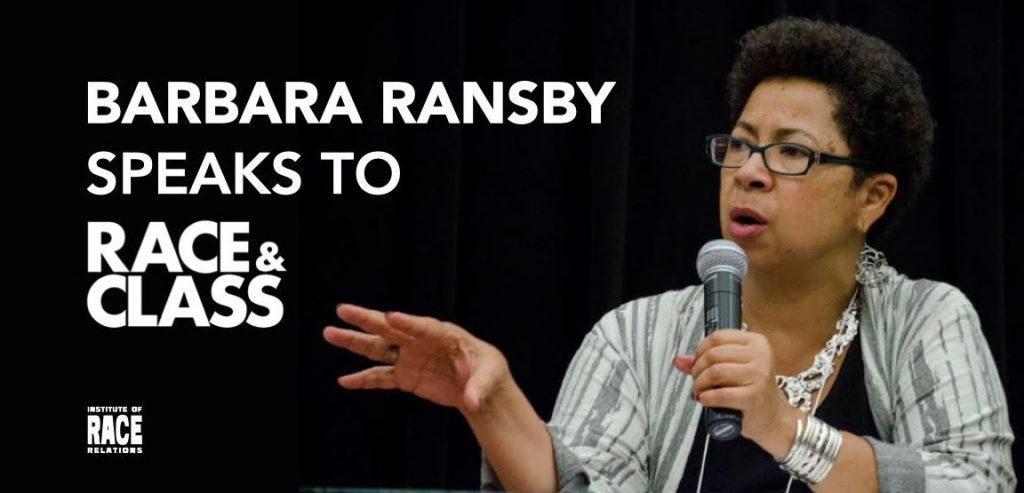As we witness one of the largest uprisings in US history, led by Black working-class activists, Race & Class interviews Barbara Ransby, a US-based historian, feminist and longtime organiser, on the significance of the Movement for Black Lives (M4BL) uprisings across the US ignited by the murder of George Floyd.
This interview is an abridged version taken from Race & Class October 2020. You can Purchase ‘A Watershed Moment’ here
Jenny Bourne: As someone who has been involved in and written on US Black working-class movements for many decades, do you see what’s happening now as a watershed moment?
Barbara Ransby: It is definitely a watershed moment and I don’t say that lightly. You know historians say every historical moment is unique which is true. But there are those pivots after which you know things are ever different and so I think this moment comes at the convergence of, in the United States and globally, really three crises.
First, it’s the crisis of liberal democracy or bourgeois democracy. We see an uptick in authoritarianism across the globe from Bolsonaro to Duterte, to Erdogan, and of course the Donald Trump phenomenon which is increasingly repressive, xenophobic, and dangerous. Essentially, Trump and his followers have deployed white nationalism in the service of racial capitalism.
Secondly, we have the global coronavirus pandemic which adds to that and stops us all in our tracks. It jolts the elites in ways that they did not anticipate, and exposes the vulnerabilities of racial capitalism yet again. Because, of course, you know it’s not lucrative to prepare for something like this, so all the pharmaceutical companies and the elite research institutes have not invested in in research around pandemics; they’d rather invest in drugs that people will buy every year because that increases the profit margin. And Trump, in his infinite lack of wisdom, dismantled the office in the federal government that was supposed to actually plan for pandemics. And then we see states and hospitals scrambling on the open market to buy life-saving equipment like ventilators. Yet another example of the failure of capitalism to meet this crisis. The market does not care if people die. We have to care.
And then the third thing is the uprising against police violence and white supremacy. We saw a fifty-state uprising in this country. We never saw that in the 1960s, we never had, 500 towns and cities with people coming out into the street simultaneously. Even in places that don’t have a significant Black population, there was somebody in that town that felt they had to get out in the streets and say something against racism, to say Black Lives Matter. That is uplifting and I have to also believe that people in those small towns probably don’t have a deep understanding of racism. They were protesting for other reasons too, unsettled and angry about the condition of their lives in this country and the George Floyd murder and the visual impact of that injustice was the final straw. The cruelty in that violence jolted people into action.
Of course an uprising is spontaneous, it is organic, you can’t script it beforehand, you can’t predict exactly when it’ll occur and you certainly can’t script it from inside as it’s unfolding. And this uprising is not different. None of us predicted that of all the outrageous acts that we have witnessed and absorbed over the last four years, that this particular killing would be the last straw for hundreds of thousands of ordinary people not in any organisation, per se.
 But, organisation is essential once uprisings begin to unfold. Movement organisations, and there are many, began to draw upon lessons and organising models and theoretical frames from earlier periods and from organisations like Critical Resistance which, of course you know, Angela Davis and Ruth Gilmore helped to found in 1997. This is an abolitionist organisation led by Black feminists. Another earlier group is INCITE!: Women of Colour Against Violence, a group that came out of the anti-domestic violence movement and insisted on including state and imperialist violence in their analysis and work. I write about these groups in my book [Making All Black Lives Matter]. But then in 2012, a new group of organisers began to congeal and they have been debating and training and doing scenario-planning and base-building in the years since. Another critical turn was, of course, the Ferguson uprising in 2014 when Michael Brown was shot dead by police in Missouri.
But, organisation is essential once uprisings begin to unfold. Movement organisations, and there are many, began to draw upon lessons and organising models and theoretical frames from earlier periods and from organisations like Critical Resistance which, of course you know, Angela Davis and Ruth Gilmore helped to found in 1997. This is an abolitionist organisation led by Black feminists. Another earlier group is INCITE!: Women of Colour Against Violence, a group that came out of the anti-domestic violence movement and insisted on including state and imperialist violence in their analysis and work. I write about these groups in my book [Making All Black Lives Matter]. But then in 2012, a new group of organisers began to congeal and they have been debating and training and doing scenario-planning and base-building in the years since. Another critical turn was, of course, the Ferguson uprising in 2014 when Michael Brown was shot dead by police in Missouri.
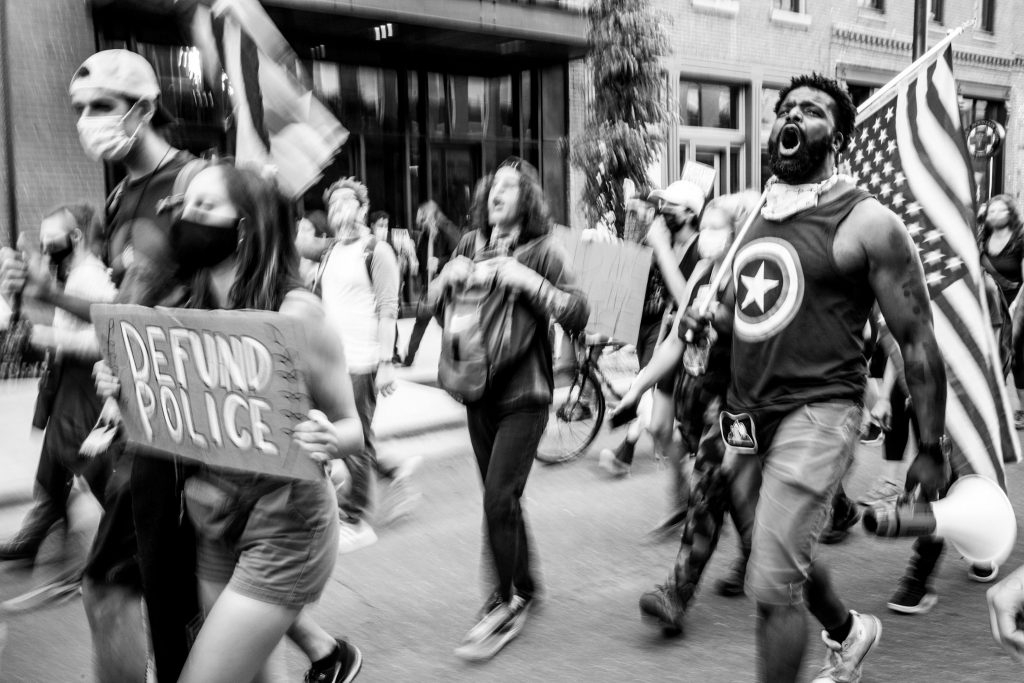
So, when the 2020 uprising occurred, you had a group of young Black activists, many of them feminists, many of them queer, many of them with a very radical intersectional analysis, ready to move into action. And they called a series of demonstrations on Juneteenth weekend. There were actions from Washington DC to California with hundreds of thousands of protesters filling the streets. The demand of ‘defund the police’ has emerged as central, reflecting decades of efforts to ‘reform and improve’ the police, all of which have failed. But ‘defund’ is only part of the agenda for activists, and it would be wrong and incomplete to leave it at that. The full-throated demand is ‘defund the police, fund our people’.
M4BL and others are organising around that idea, and M4BL’s policy committee has just created a piece of mock legislation called the Breathe Act which outlines not only dismantling police and prisons over time but also what it would mean to revitalise our communities and our schools and make health available to everyone, and have a sustainable green economy. All of that I think is a prime example of the ways in which Black liberation movements over time and in this moment are also the hopeful visionary movements for the entire planet, not just for Black people.
That’s how I would see the significance of this moment. I draw a lot from Naomi Klein’s notion of disaster capitalism. That, in this moment of disaster, in this moment of dislocation and disorientation, elites are certainly plotting and scheming on how to maximise their power, how to institute and expand policies and practices from surveillance to austerity to further their agenda. But what also happens in the context of a crisis is the opportunity for galvanising our people and galvanising the Left, and I see that happening as well.
The demonstrations here showed a certain level of determination on the part of people who attended their first protest during a pandemic. I think, regarding the Left and the Black movement here, if we don’t tap into that anger and determination then we really have not done our work. People were willing to face health risks, people went out more often than not wearing masks, but sometimes not wearing masks − taking that risk to demonstrate their outrage against what was happening in this country. They also withstood rubber bullets and tear-gas, which was in wide use, and this is really a human rights violation of the first order. I mean the cops were very brutal against a lot of the demonstrators and old people were knocked down, two reporters lost their eyes because they were victims of projectiles.
J B: It feels as if ‘Black Lives Matter’ here in the UK and in other European countries, is something of a spontaneous ‘on the street happening’, without yet the organisational framework of the US.
B R: You know Black Lives Matter is a slogan for many people. There was first a social media hashtag, that morphed into a global network. There are still there, chapters of the Black Lives Matter global network but the umbrella of the movement is the Movement for Black Lives M4BL made-up of over 100 groups. It has committees (which they call tables), it has a mass action committee, it has a policy committee, it has a solidarity committee. And that organisation which has really pulled in over a hundred organisations around the country is trying to make radical democratic decisions about direction, about movement positions, etc. It has been bringing other people in and has crucially built solidarity with other communities − with the labour movement, and so forth. On 20 July there was a strike for Black lives led by SEIU, the Service Employees International Union. A lot of people have organised under the slogan Black Lives Matter, but when I’m talking about the movement, I’m talking about the Movement for Black Lives which is a concrete a political formation, which some (not all) of the movement work lives inside of. It seems things have unfolded differently elsewhere.
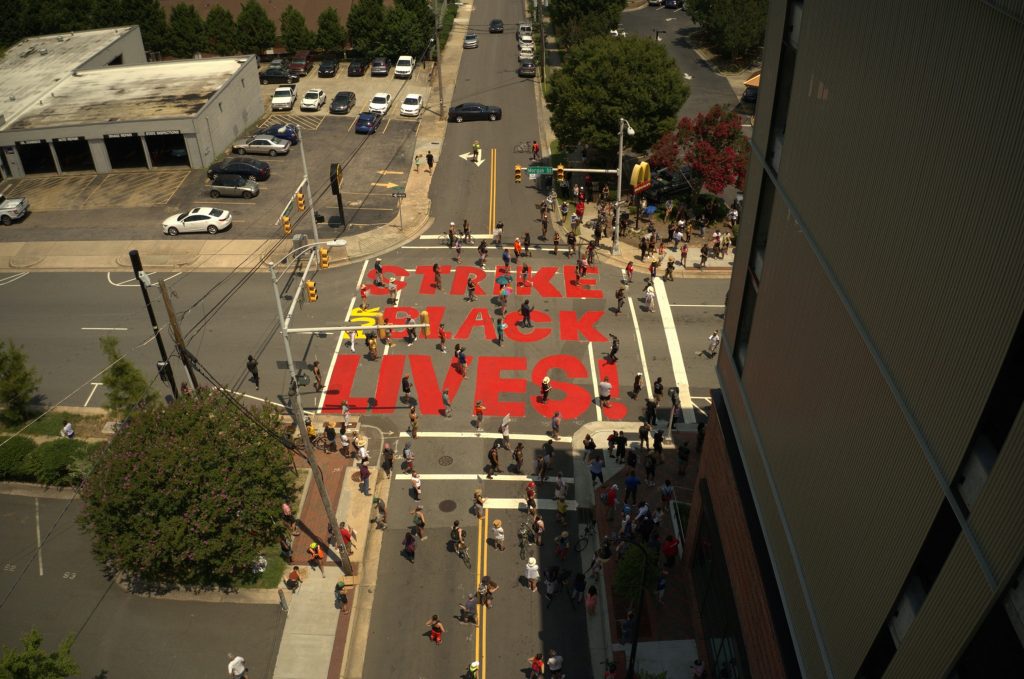
J B: In terms of where things are happening in different states, counties, or in different cities would that be locally organised or would that be part of a national decision?
B R: M4BL is not a cadre organisation or a political party; it’s an organisation of organisations. So, for example, Action St Louis has been leading some of the struggles in St Louis. It’s a completely autonomous organisation that has a representative on the leadership body of M4BL. I work with here in Chicago it’s called R3 Coalition Chicago (resist, reimagine, rebuild). We actually work with a sister network of the M4BL called The Rising Majority which is a Black-led multiracial formation that is building for a People’s Tribunal to put Trumpism on trial. Then there’s a group here of the Black Youth project100 which is a national organisation with chapters around the country that is a part of the M4BL. They are a part of M4BL. So you can think of it as a coalition, but not a coalition in the kind of old opportunistic sense of ‘we’ll coalesce until our immediate demand gets met’. It’s really trying to build movement relationships. There is a platform and we all talk about that; we all agree and sign on to that.
J B: When you say you’ve got hundreds of cities with determined people on the streets and the National Guard called in, does it mean a new level of repression, something like what happened in the 1970s against the Panthers?
B R: I’m very concerned about that. I’m concerned about a backlash and of increased surveillance, harassment and persecution. I won’t go city by city, but in some places the governors called in the National Guard [a federal force] and they were sometimes more present and more aggressive than in others. But I think that there’s another layer of the repression, a kind of backlash. People have been arrested after the event.
For example, the National Park Service has issued this kind of wanted poster for people who’ve been involved in taking down the racist pillars of colonialism, slavery and racism. They’ve taken down some of these statues of Christopher Columbus, of various slaveholders and sometimes thrown them in the river or thrown them in the lake. And there are so many cameras and there’s so much surveillance just in our everyday lives that many of the images of people doing those kinds of protests have been captured and now turned into wanted posters. So, people could conceivably be arrested in their homes or workplaces. There are, for example, two lawyers in Brooklyn who were jailed on very serious charges during the protests in New York for allegedly tossing something into a police car, damaging the car and that’s a felony. So, they were being held without bail for a good period of time. Instances like that. …Another chilling example is what has been happening in Portland, Oregon where federal agents with no name tags or insignias, just the generic ‘police’ badge – have been snatching activists off the street and herding them into unmarked cars and vans for interrogation. This is the tactic of dictatorships.
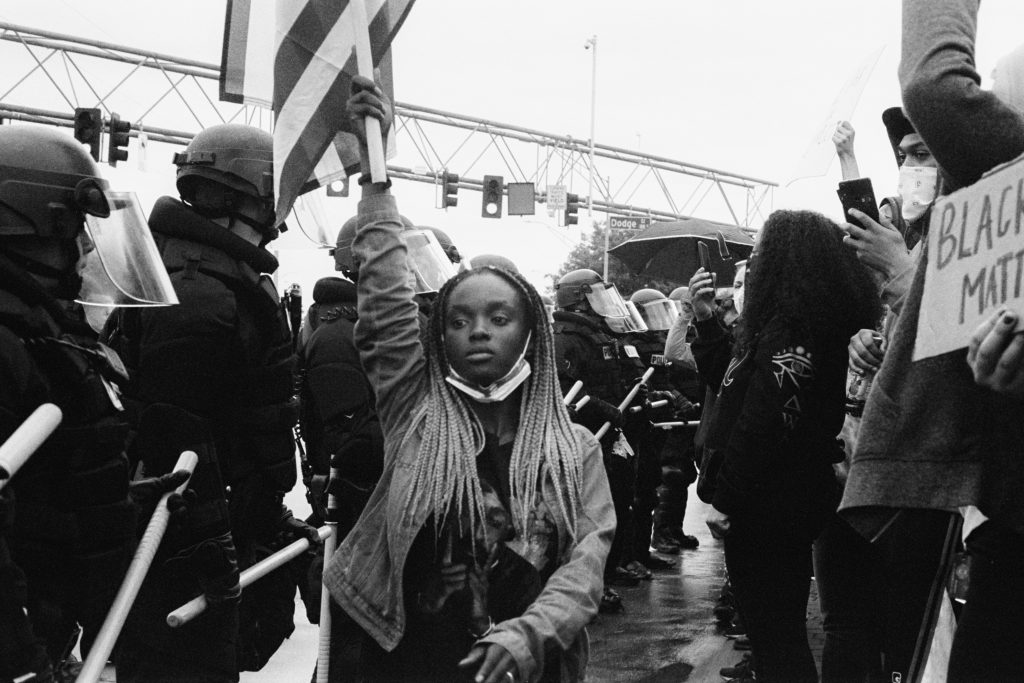
J B: There’s lots of resonances here in the UK in terms of direct repression and intimidation from the state. What we also see in the UK is intimidation of Black activists from the right-wing media. Is that a big issue in the US?
B R: Yes, Fox News, which is like ‘Trump’s state television’ has launched some pretty vicious smear campaigns. They decide to target somebody and then rake them over the coals. But it’s such a bifurcated news system here. And the mainstream media has been kind of interesting; I mean they all hate Trump so much − there has been some decent coverage, although still skewed! But The New York Times, for example, has actually hosted some really important op eds by very radical Black writers. Then we have Democracy Now, I mean I’m talking about the left press.
Now the other dynamic, when we discuss the Left, is the question of Black leadership and the ways in which a white Left ignores and marginalises Black leadership. It can reduce everybody to so-called identity politics but of course there is a vibrant Black Left. I wrote a piece in the Nation about that. It’s about internally figuring out what are the terms of the movement, what is that gonna look like, who’s gonna be in the forefront? Are we naming what this is really, an attack on the Black working class in this moment? Because it’s not college professors, lawyers and doctors that are getting attacked and killed by police. It’s not Obama’s family that’s getting thrown down on the concrete by the cops and thrown in jail. It’s people in the informal economy, it’s poor and working-class Black folks who have, in this period of neoliberalism, been pushed out of the formal economy and made vulnerable by the police industry, in the prison industry. It is the Mike Browns, the Rekia Boyds, the George Floyds of the world.
J B: We did want to ask if there was significant solidarity from the white Left or other groups in this instance but you’re seeming to imply that there’s also contradictions within how the whole movement should organise.
B R: I started off saying I think it is a watershed moment in terms of white people − some of them considering themselves left, some of them unsure where they land politically. I mean they’re not Republicans, obviously, but just people trying to make sense of a crazy world, right. People have sided with an anti-racist movement and people have followed Black leadership. But the organised Left from DSA (Democratic Socialist of America) to many of the Left publications, have a lot of work to do around anti-racism to become a stronger force. That means recognising the intimate and symbiotic connections between race and class and gender.
And then the Bernie Sanders campaign which was our big left electoral push. It had enormous potential but the fatal flaw, as is often the case, was the inability to fully deal with racism. I tried to work with them and there was a real reluctance to embrace the notion of racial capitalism, i.e., of racism and white supremacy as being intimate partners with capitalism. So, Bernie never won the kind of Black support that he could have, and he wouldn’t articulate an analysis that resonated with the masses of Black folk. We got this kind of raceless, ‘colour-blind class solidarity’, was the message, which is just not real, it becomes racist. It’s only when you define the working class as only white that you cannot deal with issues like police violence and prisons and racism. But once you look at some of the most oppressed sectors of the working class, they are people who are Black. And the way they experience class oppression is sometimes at the end of a police baton, it is sometimes by being thrown into prison, it is sometimes by being chased down and killed by vigilantes − which is happening around this country. And if you’re not concerned about that, you’re not serious.
So, there’s a struggle inside the Left which comes from two places. They’re people who have had this position for a long time: the idea that talking about race divides the working class and we should all simply ‘unite and fight’. And then there’s folks who are post-Obama colourblind advocates. They think we dealt with de jure (i.e. legal) racism and now we are in a different period where racism is less of an issue, and what the Black working class is dealing with is a class oppression only, shared by white workers. This argument just does not hold water.
But, there are groups that are forging a race, class and gender analysis: from Grassroots Global Justice Alliance, Indigenous Environmental Network to United We Dream, which is primarily Latinx organisations, both have been in very strong solidarity with M4BL. There’s a group called SURJ (Showing Up for Racial Justice) which is not a radical group but it’s a good anti-racist white group, and they have stepped up too. And the SEIU, I mentioned, is led by a white woman president but it has many, many Black members and leaders – they have taken a stance with the movement, as has the Chicago Teachers Union. There are such groups stepping up and not saying they are just ‘allies’ any longer, but saying they are accomplices and co-conspirators. Solidarity across racial lines is very real. Many of the organisers in the M4BL work in larger coalitions and in multiracial organisations; some of them have worked internationally.
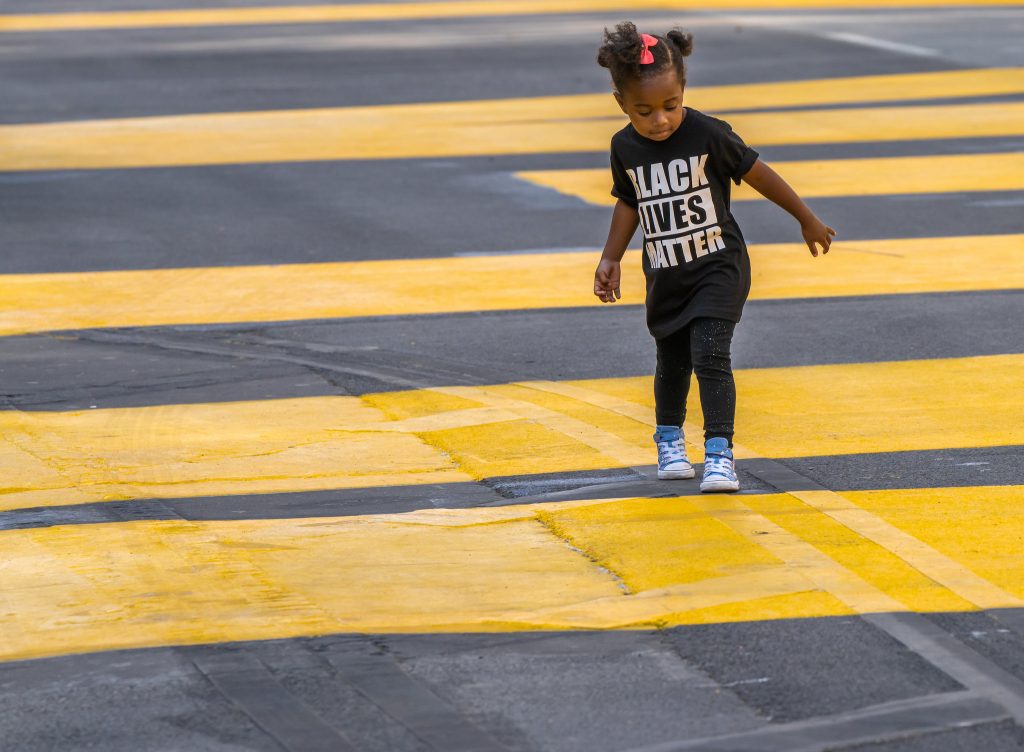
J B: Has there been a significant shift in the way that racism is seen, is there a bigger move towards understanding racism as a structural thing?
B R: There’s always been a segment of the movement that understood the structural nature of racism, I mean going back even to King in the 1960s. So, this is not a ‘discovery’. By the end of King’s life he was talking about structural racism, imperialism and capitalism. So, there is still a competing liberal analysis that says, ‘can’t we all get along’, we’re all just different colours, the multiculturalism of thirty-one flavours of humanity. But serious organisers have not advanced this simplistic notion. I am impressed that activists are also seeing beyond simple representational politics. In other words, Black faces in high places is no solution.
It is significant not only did the M4BL emerge under the nation’s first Black president but this movement has targeted the police as a repressive force, no matter their colour. And virtually all urban police forces have a significant number of Black cops. And some of our cities are run by Black mayors, some of them have Black police chiefs. And people are crystal clear that that does not give them a pass, that they are not on our side. They are naming the work that they do for the system − it’s still racism. Apartheid was racism, even though you had Black people in the townships who were paid by the system to beat the shit out of protesters in the uprisings in places like Soweto. It was still organised systemic racism, even if you had Black collaborators implementing the policies in certain places. People are clearer than they’ve ever been about that question.
J B: In your book, you called Black feminist politics the bedrock of M4BL; is gender still key?
B R: I do think it’s important to talk about gender politics. Some of the most amazing leaders, some of the most articulate spokespersons, some of the most tireless fighters in this struggle are women: Thenjiwe McHarris, Karissa Lewis, Chinyere Tutashinda, Nikita Mitchell, Kayla Reed, Charlene Carruthers, Rachel Gilmer, N’tanya Lee, and Dee Dee Jackson, to name only a few. At the same time, some of the most high-profile cases of police violence have been Black men − George Floyd, Ahmaud Arbery, Michael Brown going back to 2014, Rayshard Brooks (in Atlanta last month) and so on, but there have been a number of women victims of course as well. Breonna Taylor in Louisville was killed in her home in March; and trans and gay victims, particularly trans. The transphobia, trans hatred is really intense and people feel that these individuals can be punching bags and can be mocked and hurt. I am so proud of this moment that has said, No. No one deserves this. We will not tolerate this. We will not disown any of our people. And I think that’s very hopeful, even though there is more work to do internally and in society about homophobia and transphobia.
The current Black movement in the United States represents the influence of Black feminism and its holistic approach toward liberation. It’s not surprising that many of the leaders of M4BL are people, some of whom come out of a Black feminist and queer politics − questioning every aspect of what this system tells us about who we have to be to get what we deserve. They have felt oppression from all sides and created new possibilities for themselves inside of communities, and now are in a sense ambitious for all of the rest of us and for the world.
When we talk about abolition, we do a shorthand; for we’re not just talking about abolishing, we’re talking about building. Abolition is a potentially revolutionary and radical demand because you’re saying we can’t just patch up the system that we live under. We have to rethink it, we have to dismantle it, we have to have something fundamentally different. To abolish without building leaves us vulnerable. We have to build new institutions, we have to build new power, we have to build a new system, and we have to become different people in the process. I have learned these lessons from Angela Davis, Ruth Wilson Gilmore, and my own activist daughter, Asha Ransby-Sporn.
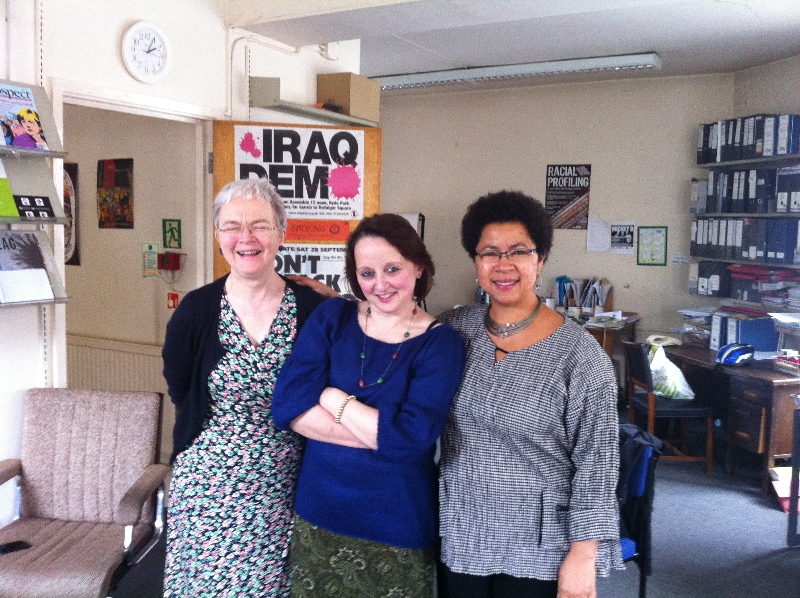
This interview took place on July 2020. The full version of this interview is published in the October 2020 issue of Race & Class.
Related links
Buy Race & Class 62.2: ‘A Watershed Moment’
Resist Reimagine Rebuild Coalition Chicago, ‘Building Unity and Resistance’
‘The Rising Majority: building a powerful Left for radical democracy’
BYP100, ‘We ready, we coming!’
Barbara Ransby, ‘The white Left needs to embrace Black leadership’

